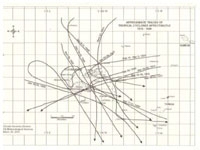
A Consolidated High Quality Database of Southern Hemisphere Tropical Cyclones
Howard J. Diamond – NOAA/National Climatic Data Center and Auckland University David Jones and Yuriy Kuleshov – Australian BoM/National Climate Centre
Over the past couple of years, a project has been undertaken and funded by the Australian Bureau of Meteorology, NOAA’s National Climatic Data Center, and the Australian (BoM) Greenhouse Office in order to improve the quality of Tropical Cyclone (TC) data in the Southern Hemisphere (SH) that includes the following three basins: (1) the South Indian Ocean from 30 °E to 90 °E; (2) the Australian region from 90 °E to 135° E; and (3) the Southwest Pacific basin from 135 °E to 120 °W. This geographic breakout while not matching the formal World Meteorological Organization areas of forecast responsibilities, are done so from a climatological rather than forecast area perspective that essentially falls into some natural breakout patterns related to the longitude crossing of storms.
Project Aims
The objective of this project centres around three prime areas: (1) to develop a high-quality tropical cyclone database for the South Pacific and Indian Oceans including Australia, covering tracks and intensity; (2) to provide observational data for verifying and better understanding climate model projections of tropical cyclone changes, including potential changes due to the influence of global warming; and (3) to develop a range of web-based tools to support the use and dissemination of data and analyses coming out of this project. Essentially, the project started with an examination of the South Pacific and South Indian portions of the existing SH TC database at the BoM was closely examined with particular attention paid to TC records obtained from the various national meteorological services databases in Australia, La Réunion, Fiji, New Zealand, and New Caledonia beginning with the 1969/70 TC season, which is considered the start of the satellite record.
Data recovery and processing
In addition, paper data from various sources in the Southwest Pacific, prior to the satellite era, are being digitized in an attempt to bring the SH TC database back to as far as is possible. Some discrepancies among the datasets were identified and are being rectified. Best track tropical cyclone data from the National Meteorological and Hydrological Services for 1969/70 to 2005/06 TC seasons were obtained, verified and quality of records was improved. A high-quality TC database for the South Pacific and the South Indian Ocean, incorporating the Australian region, was compiled, and a specialized website for disseminating results and data was developed that can be found at http://www.bom.gov.au/climate/change/.
Future directions for tropical cyclone research
On-going work involves the development of a climatology of TCs in the Southwest Pacific and South Indian Ocean basins, thereby providing an improved estimate of the climatological risks posed by these storms as well as the associated vulnerability of low-lying island states to the effects of TCs. In addition, an effort to document and analyze TC variability and trends in the basins, to evaluate observed trends and relationships to climate change, is underway. Finally, work is taking place to develop an experimental seasonal forecasting scheme for tropical cyclones thereby informing communities of conditions favorable to both active as well as inactive TC seasons.
Howard Diamond has worked for NOAA since 1981 and is the U.S. Global Climate Observing System program manager. David Jones is the head of climate analysis at the Australian Bureau of Meteorology. Yuriy Kuleshov is a climate researcher in the National Climate Centre based at the Australian Bureau of Meteorology.
